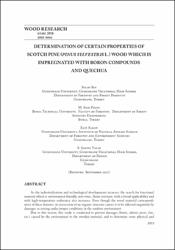DETERMINATION OF CERTAIN PROPERTIES OF SCOTCH PINE (PINUS SYLVESTRIS L.) WOOD WHICH IS IMPREGNATED WITH BORON COMPOUNDS AND QUECHUA

Access
Attribution 3.0 United Statesinfo:eu-repo/semantics/closedAccesshttp://creativecommons.org/licenses/by/3.0/us/Date
2018Access
Attribution 3.0 United Statesinfo:eu-repo/semantics/closedAccesshttp://creativecommons.org/licenses/by/3.0/us/Metadata
Show full item recordAbstract
As the industrialisation and technological developments increase; the search for functional material which is environment-friendly, non-toxic, flame resistant, with a broad applicability and with high-temperature endurance also increases. Even though the wood material corresponds most of these features, its possession of an organic structure causes it to be affected negatively by damages occurring under proper conditions in the outdoor environment. Due to this reason, this study is conducted to prevent damages (biotic, abiotic pests, fire, etc.) caused by the environment to the wooden material, and to determine some physical and mechanical properties of wooden material impregnated with quechua, borax and boric acid, which are used to extend the usage life. Those features are needed in an outdoor environment. The Scotch pine (Pinus sylvestris L.) test specimens are prepared with borax, boric acid, borax+boric acid, from borax compounds, which have a great potential in Turkey, and with quechua, one of the natural impregnation substances. Then these samples are impregnated with three different (1%, 3%, 5%) solution concentrations according to ASTM 1413-76 standards and some physical-mechanical property changes are investigated. After impregnation, samples are tested and compared with control samples. According to the test results; the lowest oven dried density change is obtained in borax as 0.46 g.cm(-3) in terms of boron compounds and the retention amount is determined to be highest with 3.83 k.gm(-3) in the samples impregnated with boric acid. The bending strength and elastic modulus are found to be highest with 83.53 MPa and 10281 MPa in the samples impregnated with boric acid. When examined at the concentration level, it is determined to be highest with 81.89 MPa in samples with 3% concentration. There are statistical discrepancies with 55.77 MPa in the comprehensive strength parallel to grain in boric acid in terms of boron compounds.
Volume
63Issue
6Collections
The following license files are associated with this item:


















